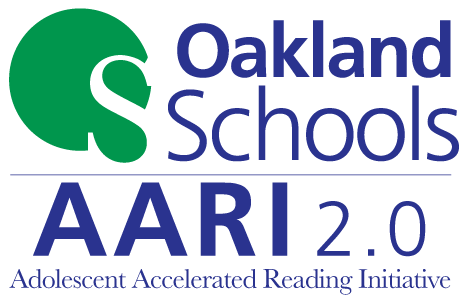
Research & Data

ALL AARI Educators are Welcome!
What: Join AARI classes to see students and teachers in action and engage in practice-centered dialogue with other AARI educators.
How: Some Learning Labs will be in-person during the school day. Other Learning Labs will be virtual from 4-5:30 pm.
Registration information is shared through the AARI email listserv. If you are not on the listserv and would like to be added, please email [email protected].
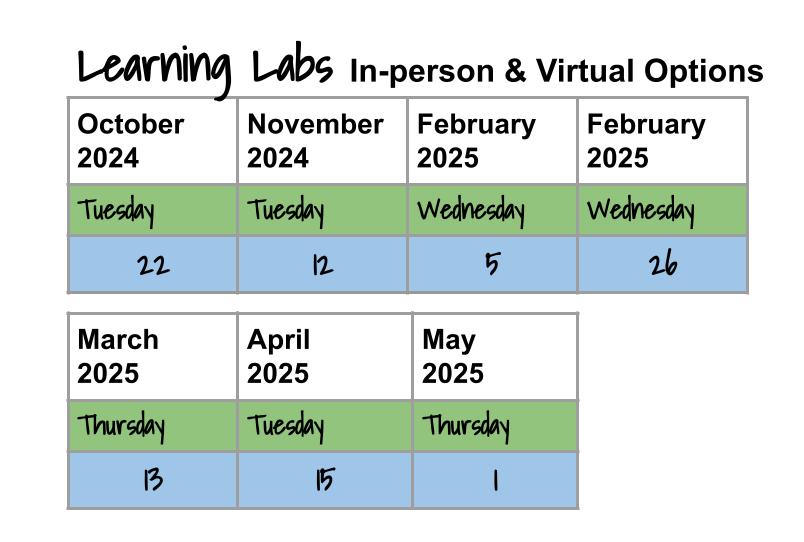

Join us for a full year of professional learning that includes:
5-day Summer Institute
AND a minimum of 15 additional hours during the school year. Choose from:
PLUS 2 (minimum) job-embedded coaching sessions
Self-paced, online QRI modules
State required clock hours (SCECHs) available
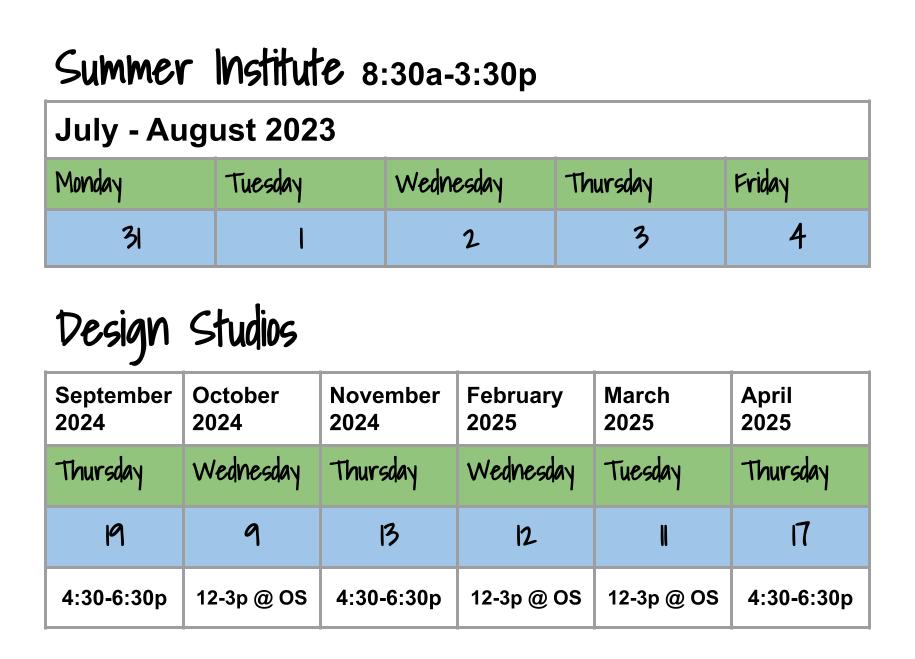

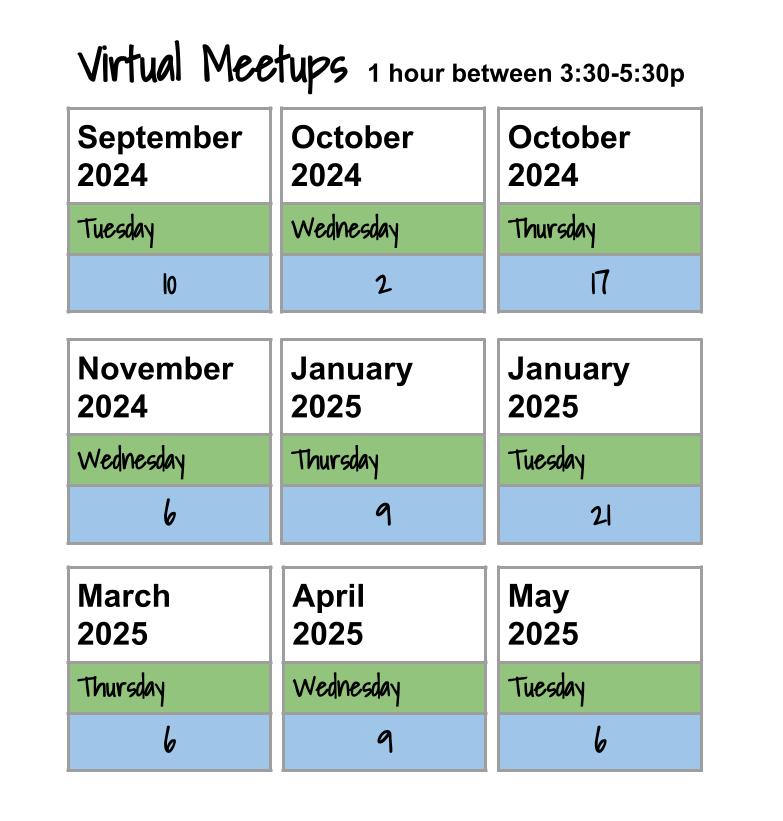

When: July 31-August 1, 2024 from 9:00a-3:00p
What: Advanced AARI is two days of professional learning to build deeper understanding of the AARI framework and collaborate with AARI colleagues. In this blended format, AARI educators engage in whole group learning and breakout sessions around participants’ topics of interest. This is for educators who have attended the AARI (or ACRI) Institute.
Where: In-person at Oakland Schools Conference Center
Registration information is shared through the AARI email listserv. If you are not on the listserv and would like to be added, please email [email protected].
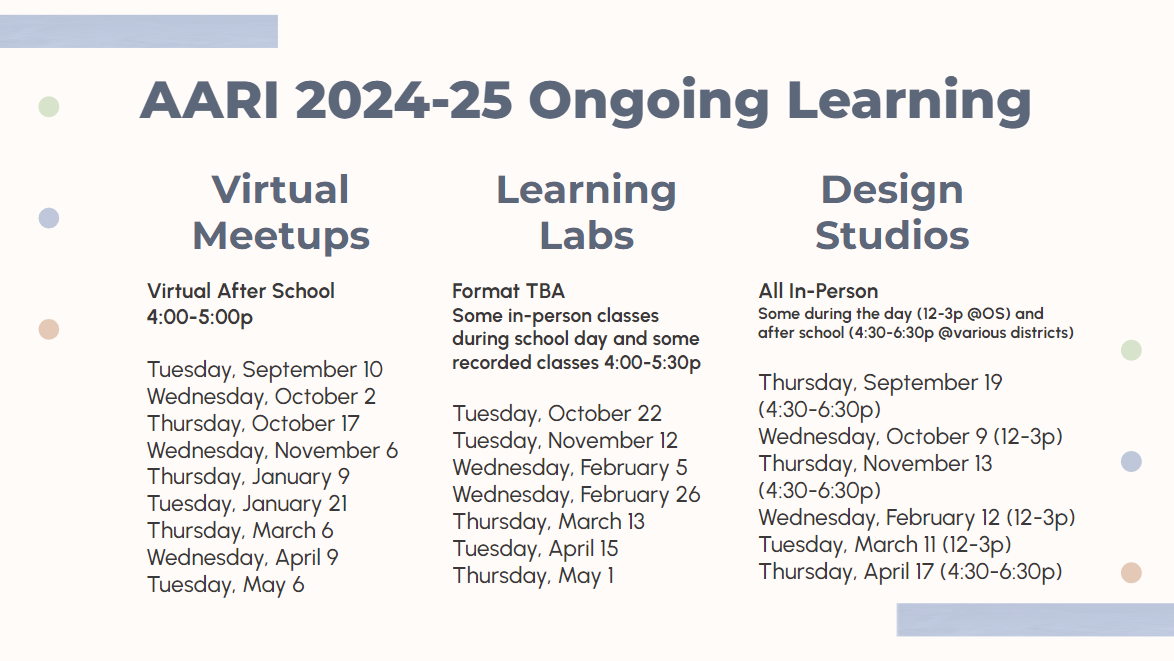
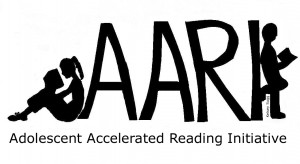 Although it is already October, and classrooms around the county are settling into their practices, teachers are still focusing on how they will foster and fuel their learning communities.
Although it is already October, and classrooms around the county are settling into their practices, teachers are still focusing on how they will foster and fuel their learning communities.
Teachers of the Adolescent Accelerated Reading Initiative, an initiative to quickly bring students to grade level in reading skills, need to be especially vigilant in their community building. It’s important to build community to gain credibility as an advocate, to promote buy-in to AARI, and to encourage thoughtful conversations.
Building a community with readers can be challenging – you’ve got so many different reading levels, different student interests, and different backgrounds to meld together.
And building a community with struggling AARI readers can be overwhelming. To do so, you have to convince students that AARI is going to help them become successful readers. You also have to convince them that the books you are using (although they look like “baby” books) are going to be challenging because of the work you will do with them, and that this class is going to help them think in new and life-changing ways.
So how do you create a strong learning community?
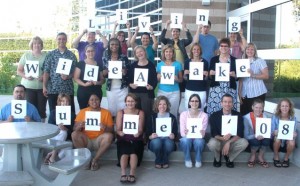 Oakland Writing Project’s Summer Institute in 2008 was the most powerful learning community I have been a part of. Never have I felt so connected to people I had never known, and in such a short period of time. As I recall our time together and consider what exactly led to our strong community, several key elements surface.
Oakland Writing Project’s Summer Institute in 2008 was the most powerful learning community I have been a part of. Never have I felt so connected to people I had never known, and in such a short period of time. As I recall our time together and consider what exactly led to our strong community, several key elements surface.
At Oakland Writing Project’s 2008 Summer Institute, we:
Building a community of AARI readers isn’t easy. But by looking at learning communities that have been successful, we can refocus our teaching practices, and continue to offer the best support to our students.
Caroline Thompson (@TeacherThompson) taught middle school ELA for 12 years in Lake Orion before becoming a stay-at-home mom. She supports AARI teachers for Oakland Schools as an independent consultant in the areas of digital media, professional development, and non-fiction resources. Caroline is a Reading and Writing Workshop advocate, a 2008 Oakland Writing Project Teacher Consultant, and a 2009 Oakland County Outstanding Teacher of the Year Nominee. She lives in Berkley with her husband and their 2 year old daughter.
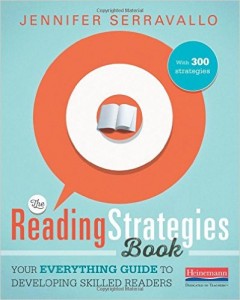 During the second half of the school year, I opened my classroom up to a doctoral student from the University of Michigan who was studying what untaught and sometimes intangible things make teachers successful. It was a wonderful experience, and I learned a lot about myself as a teacher through the reflective nature of the process. As compensation for my time and energy, I was presented with a $100 gift card for Amazon. I knew exactly what I would buy: books! One book, in particular, was on my wish list, Jennifer Serravallo’s The Reading Strategies Book. I had seen the publisher, Heinemann, promoting it on Twitter, and it looked really useful and practical for teachers on a day to day basis.
During the second half of the school year, I opened my classroom up to a doctoral student from the University of Michigan who was studying what untaught and sometimes intangible things make teachers successful. It was a wonderful experience, and I learned a lot about myself as a teacher through the reflective nature of the process. As compensation for my time and energy, I was presented with a $100 gift card for Amazon. I knew exactly what I would buy: books! One book, in particular, was on my wish list, Jennifer Serravallo’s The Reading Strategies Book. I had seen the publisher, Heinemann, promoting it on Twitter, and it looked really useful and practical for teachers on a day to day basis.
The book arrived in early June, and I set it aside to look at once the school year ended. In mid-June, I was a presenter in the 6-8 Informational Reading & Writing strand at the MiELA Network Institute. I hadn’t yet looked through The Reading Strategies Book, but I threw it into my crate just in case I got some extra time. My co-presenter, Cory Snider (@sniderc), and I wanted to be especially mindful of the needs of our participants since a number of them were returning from the year prior. So as we were looking through the exit comments at the end of day two and thinking about our plans for day three, I grabbed The Reading Strategies Book out of my crate and started skimming it.
Based on the reviews I had seen, I had a hunch the book was going to be good, but I didn’t know just how good it would be. As Cory was busy trying to put the finishing touches on our presentation for the next day, I kept yelling, “Cory! Look at this one! It’s perfect!” or “Cory! Isn’t this just the best idea?!” While he did agree that the book seemed pretty great, I think he probably could have done without my outbursts every 30 seconds. We ended up incorporating a number of Serravallo’s strategies into our plans for the next day, and the participants were just as excited as we were about the potential of this book. One group of participants is even planning to use it in their PLC’s next book study based on our recommendation.
The beauty of The Reading Strategies Book is in its simplicity, consistency, and organization. The 300 (!) strategies are broken up by goal, which mimic goals that we might have as teachers as we help students navigate various text types. These goals range from support for early readers to comprehending fiction in a variety of ways to improving comprehension of nonfiction to deepening students’ speaking and listening skills. Serravallo has organized her book so that each strategy fits onto one page, which includes:
I have so many pages bookmarked, especially in the nonfiction sections. I anticipate using this book regularly, and I’ve already told a number of my colleagues about it. A science teacher in my building even saw a tweet I made about it and wants to see how it can help her support her students’ understanding of science texts.
 Jianna Taylor (@JiannaTaylor) is an ELA and Title 1 teacher at Orchard Lake Middle School in West Bloomfield. She is a member of the AVID Site Team and Continuous School Improvement Team at her school, among other things. She is also a MiELA Network Summer Institute facilitator and member of the OWP Core Leadership Team. Jianna earned her bachelor’s degree from Oakland University and her master’s degree from the University of Michigan. She also writes reviews of children’s books and young adult novels for the magazine Library Media Connection.
Jianna Taylor (@JiannaTaylor) is an ELA and Title 1 teacher at Orchard Lake Middle School in West Bloomfield. She is a member of the AVID Site Team and Continuous School Improvement Team at her school, among other things. She is also a MiELA Network Summer Institute facilitator and member of the OWP Core Leadership Team. Jianna earned her bachelor’s degree from Oakland University and her master’s degree from the University of Michigan. She also writes reviews of children’s books and young adult novels for the magazine Library Media Connection.
I have a son in high school who is, by all measures, a skilled reader and a dedicated student. When he reads for school, much to his chagrin, I tend to bug him by asking him lots of annoying questions. I do this in part because I am a concerned parent who wants to stay in touch with my son’s education. However, I also do it because I’m a literacy researcher at heart and I want to see what and how he is thinking when engaged in school-related reading.
 In the course of my meddlesome investigations, I noticed an interesting pattern across his assigned reading of three different novels. For all of his novel reading, he was expected to use the FIDDS protocol, in which he was directed to analyze Figurative language, Imagery, Diction, Details, and Syntax. This protocol (often used in AP English and IB ELA classes) is intended to help students focus on elements an author uses to develop tone or express style. Students are then supposed to consider how style or tone contributes to the larger themes, purposes, or meanings of the text. In my son’s case however (and likely for many other students), the use of the protocol became the end for him, and not the means through which he understood the text.
In the course of my meddlesome investigations, I noticed an interesting pattern across his assigned reading of three different novels. For all of his novel reading, he was expected to use the FIDDS protocol, in which he was directed to analyze Figurative language, Imagery, Diction, Details, and Syntax. This protocol (often used in AP English and IB ELA classes) is intended to help students focus on elements an author uses to develop tone or express style. Students are then supposed to consider how style or tone contributes to the larger themes, purposes, or meanings of the text. In my son’s case however (and likely for many other students), the use of the protocol became the end for him, and not the means through which he understood the text.
As I understand the task he was assigned, he was expected to identify a minimum number of FIDDS examples and connect them to identified themes of the books in the process of a writing a literary analysis. For example, for one book he looked for examples of imagery and figurative language used by the author to develop the idea that love can both heal and hurt. With this task laid out before him, his reading then focused on finding and explaining the examples… he wasn’t really engaged with the larger narrative of the novel or the human problem it was exploring, nor was he focused on developing a cohesive analysis of the book’s theme. When I asked about the larger conflict of the novel and why this novel was worth reading, he replied that his assignment didn’t require him to think about that; he just had “to find these examples and write a short paragraph about each one.” The benefit to this was that he learned about literary devices and had the opportunity to consider them in use. The drawback was that he lost an opportunity to consider the larger value of the book as he read; he wasn’t reading with important questions in mind, just the task. In fact, once he identified a sufficient number of examples and satisfied the requirements of the protocol as assigned, he felt that this part of his work was done, and he no longer seemed to actively consider how the theme continued to be developed by the author. Reviewing his work and the book, I found quotes and sections that would have better served his analysis, but he felt that he didn’t need to use them because he already had examples for those particular FIDDS elements. He explained to me again, patiently but on the verge of annoyance, that he was completing the FIDDS task as directed, and that what I was asking for (a thematic analysis of the book supported by multiple examples) was not what he was supposed to do. I’m quite certain, however, that the goal of using FIDDS is to develop effective literary analyses, but in this case, finding examples of FIDDS had become the goal itself.
 We educators love our strategies, routines, and protocols though, especially with respect to reading. Indeed, much of the professional learning that I do with teachers involves, to varying degrees, strategies and routines. So my purpose here is not to say that protocols or strategies are inherently problematic, but rather I want to argue that we run the risk of minimizing the value of strategies if we use them in isolation, overuse them, use them when they don’t really fit, or use them without processing or connecting them to larger themes/concepts.
We educators love our strategies, routines, and protocols though, especially with respect to reading. Indeed, much of the professional learning that I do with teachers involves, to varying degrees, strategies and routines. So my purpose here is not to say that protocols or strategies are inherently problematic, but rather I want to argue that we run the risk of minimizing the value of strategies if we use them in isolation, overuse them, use them when they don’t really fit, or use them without processing or connecting them to larger themes/concepts.
The challenge of effectively using learning strategies for reading isn’t just a problem in ELA classrooms either. I’ve seen similar issues in many social studies classes. Reading protocols like APPARTS and SOAPSTone present the same problems. APPARTS stands for: Author, Place and time, Prior Knowledge, Audience, Reason, The main idea, and Significance; it is meant to be used when students analyze primary documents. SOAPSTone is similar and asks students to identify, for any document they read, the Speaker, the Occasion, the Audience, the Purpose, the Subject, and the Tone. These approaches stem from the idea that historians question the contexts and sources of documents as a part of their disciplinary practices. What sometimes gets left out for students, however, is WHY historians approach reading this way. Historians consider these textual elements as they gather and analyze evidence from documents in the process of trying to resolve an historical problem. For historians, the source and context of a document shape its larger meaning and value as evidence. Absent a good driving, historical question to focus these approaches, such protocols become decontextualized lists of steps for students to complete. This is particularly true when students are asked to use such a routine for every single document they read. When the use of the protocol or strategy becomes the outcome, students miss out on the important process of considering why to use such a tool in the first place. In other words, if students are asked to use these routines but are never engaged in thinking about how this information (source, context, etc.) actually matters in an historical investigation, the work becomes just another routine task.
I want to clearly state that I’m not criticizing my son’s teacher, or any teacher, for using these kinds of tools. I use them myself when I teach. Rather, I want us to honestly reflect on how we currently use such strategies and then talk about how we can use them more effectively! The following questions are constantly on my mind now as I think about this problem:
There are no simple answers to these questions, by the way, and that’s okay. We just need to ask ourselves these questions as we teach and constantly seek to get better at what we do. Even so, I think that the last question above is particularly important and merits a bit of unpacking. I carried out professional development in one district where everyone had been trained in Thinking Maps, and the teachers were required to use Thinking Maps at regular intervals. In this context, instructional planning began to revolve around the strategy and was no longer driven by students’ needs and content learning goals. Administrators would visit classrooms looking for Thinking Maps instead of looking and listening for evidence of student learning. Teachers collected data on their use of Thinking Maps, not on students’ learning of new concepts and skills. The completion of the Thinking Maps became the goal of teaching, and the learning of content was backgrounded. Now, I’m sure that students learned content at some point in this process, but no one ever stopped to ask if Thinking Maps were the most appropriate strategy for each given lesson in which they were used (especially after the district invested lots of money in materials and training!). In this situation, most teachers did what many students do: they completed the task without ever really thinking about the tools or considering alternatives.
Now, I get why this happens. Administrators are under pressure to show “best practices” in their buildings, and there is certainly value in developing common language across classrooms with shared approaches. Requiring everyone to use the same strategy might make some sense as a first step, but never going beyond that and introducing a range of malleable, alternative practices seems very problematic to me. Even more problematic is the use of strategies for reading that is NOT driven by interesting, content-rich questions.
 So what is the solution? How, for example, would I adapt my son’s assignment? I think I would have backgrounded FIDDS for starters, asking students instead to read with a larger question in mind. I would have asked students to read the novel as a means of engaging with a range of big, important questions connected to possible themes in the book. I would then have students track the development of this theme and develop claims about the author’s perspective on our driving questions, perhaps focusing in on key chapters (depending upon the book). I would ask students to identify multiple examples of how the theme surfaced in the novel and then discuss how these examples might suggest the perspective of the author. I would then have students make claims about how the author integrated her perspective on the theme into the book, and then review their reading notes to select the best evidence to support their claims (after having worked with them around standards of evidence for literary analysis). At this point, students could use FIDDS to help them analyze their evidence and consider the types of evidence they had found, and perhaps go back into the book to look for other types of evidence. In this scenario, students would use FIDDS to serve the larger purpose of reading, FIDDS would not be the purpose itself.
So what is the solution? How, for example, would I adapt my son’s assignment? I think I would have backgrounded FIDDS for starters, asking students instead to read with a larger question in mind. I would have asked students to read the novel as a means of engaging with a range of big, important questions connected to possible themes in the book. I would then have students track the development of this theme and develop claims about the author’s perspective on our driving questions, perhaps focusing in on key chapters (depending upon the book). I would ask students to identify multiple examples of how the theme surfaced in the novel and then discuss how these examples might suggest the perspective of the author. I would then have students make claims about how the author integrated her perspective on the theme into the book, and then review their reading notes to select the best evidence to support their claims (after having worked with them around standards of evidence for literary analysis). At this point, students could use FIDDS to help them analyze their evidence and consider the types of evidence they had found, and perhaps go back into the book to look for other types of evidence. In this scenario, students would use FIDDS to serve the larger purpose of reading, FIDDS would not be the purpose itself.
Reading with no clear purpose just becomes an exercise in task completion, and if many of our students operate in this mode, it is because they have learned to do so in our schools. If we want students to think deeply as they read, then we need to anchor our instruction in big, conceptual problems that connect to the texts they are reading. This requires us to foreground disciplinary thinking and problem solving in which questions come first and tools are adapted or shaped depending upon the context. Of course, teaching in this way is not easy work. It requires lots of time and constant reflection, and students are not likely to appreciate more complex tasks in the beginning! Nevertheless, if we want our students to go deeper in their learning and reading, then we have to design and scaffold instructional activities that move them in this direction. Reading protocols and strategies can be of great help in this work, but only when they are processed and used carefully as the means to an end, and not as the end in and of themselves.
 Darin Stockdill is the Content Area Literacy Consultant at Oakland Schools. He joined the Learning Services team here in 2011 after completing his doctorate in the area of Literacy, Language, and Culture at the University of Michigan’s School of Education. At Michigan, he taught content area literacy methods courses to pre-service teachers (and was named a School of Education Outstanding Instructor in 2010) and researched adolescent literacy, with a focus on the connections (or lack thereof at times) between youths’ academic and non-academic literacy practices. Before this stint in academia, Darin was a classroom Social Studies and English teacher in Detroit for 10 years, working with both middle and high school students, and he also took on curriculum leadership roles in his school. Before teaching at the secondary level, he worked as a substance abuse and violence prevention specialist with youth in Detroit, and also taught literacy and ESL to adults in Chicago.
Darin Stockdill is the Content Area Literacy Consultant at Oakland Schools. He joined the Learning Services team here in 2011 after completing his doctorate in the area of Literacy, Language, and Culture at the University of Michigan’s School of Education. At Michigan, he taught content area literacy methods courses to pre-service teachers (and was named a School of Education Outstanding Instructor in 2010) and researched adolescent literacy, with a focus on the connections (or lack thereof at times) between youths’ academic and non-academic literacy practices. Before this stint in academia, Darin was a classroom Social Studies and English teacher in Detroit for 10 years, working with both middle and high school students, and he also took on curriculum leadership roles in his school. Before teaching at the secondary level, he worked as a substance abuse and violence prevention specialist with youth in Detroit, and also taught literacy and ESL to adults in Chicago.
 Kids in schools today get tested, evaluated, assessed, analyzed, and then tested some more. In this process, students often end up with a wide range of scores attached to their names, from MEAP scores to NWEA scores to grade level equivalency scores to recommended lexile levels for reading. We may be, as the saying goes, “data rich and information poor.” We have lots of statistics and other data, but we’re not really sure how to use it all. This is particularly true when it comes to reading. I often hear teachers describe their students as readers by assigning grade levels for their reading abilities, as in “she’s in the 9th grade but she reads at the fourth grade level.” This grade level labeling, for lack of a better term, is especially common in our talk about young people who are not meeting the academic expectations placed on them at school. Statements like, “half of my students are reading two grades below level,” are pretty common in my conversations with teachers concerned about their students’ reading skills.
Kids in schools today get tested, evaluated, assessed, analyzed, and then tested some more. In this process, students often end up with a wide range of scores attached to their names, from MEAP scores to NWEA scores to grade level equivalency scores to recommended lexile levels for reading. We may be, as the saying goes, “data rich and information poor.” We have lots of statistics and other data, but we’re not really sure how to use it all. This is particularly true when it comes to reading. I often hear teachers describe their students as readers by assigning grade levels for their reading abilities, as in “she’s in the 9th grade but she reads at the fourth grade level.” This grade level labeling, for lack of a better term, is especially common in our talk about young people who are not meeting the academic expectations placed on them at school. Statements like, “half of my students are reading two grades below level,” are pretty common in my conversations with teachers concerned about their students’ reading skills.
So what did his “fourth grade reading level” score really mean, was it at all useful, and what was getting lost in the process of using this score to describe him as a reader? The fourth grade reading level meant that on one particular day, he answered most of the multiple choice questions right about a text that a testing company like ETS or Pearson decided was something that most fourth graders should be able to read with little difficulty. When presented with questions about more complex texts, he probably began to get lots more questions wrong. That is what his 4th grade level reading score meant.
Don’t get me wrong though – this score does have some use as a general screening tool. A very low score on a generic reading test lets us know that we need to pay attention to how this student reads a wide range of different texts, and it lets us know that he likely needs additional support for reading. It does NOT tell us, however, that he can’t read any text above a fourth grade level, and it does not tell us that he is incapable of thinking deeply about a wide range of texts. It tells us only that he struggled with the texts on this test. This is important to remember because not all texts, and not all reading activities, are the same. Thus, when properly motivated, and when armed with in-depth prior knowledge, this kid can likely read far above his assigned level.
I s this important to know? Of course it is, because if we can find ways to motivate him and build prior knowledge before reading, we can help him move far beyond his test score. However, if we think he can’t read more advanced texts, we might never ask him to him read, or we might just give him low-level texts when we can find them. We might never challenge him to use the resources he already has to become a better reader, and we might allow him to move into learned helplessness and believe that he doesn’t have the potential to read advanced texts well.
s this important to know? Of course it is, because if we can find ways to motivate him and build prior knowledge before reading, we can help him move far beyond his test score. However, if we think he can’t read more advanced texts, we might never ask him to him read, or we might just give him low-level texts when we can find them. We might never challenge him to use the resources he already has to become a better reader, and we might allow him to move into learned helplessness and believe that he doesn’t have the potential to read advanced texts well.
The big picture is that reading is a complex process… there are many factors involved in reading comprehension, and when we reduce a kids’s reading to one single score, we may be missing pieces of their reading puzzle. So what’s the solution? Some initial steps are outlined below:
Alvermann, D.E. (2001). Reading adolescents‘ reading identities: Looking back to see ahead. Journal of Adult and Adolescent Literacy 44: 676-690.
Dutro, E., Selland, M., & Bien, A (2013). Revealing Writing, Concealing Writers: High- Stakes Assessment in an Urban Elementary Classroom Journal of Literacy Research 45(2):99
Franzak, J. (2006). Zoom: A review of the literature on marginalized adolescent readers, literacy theory, and policy implications. In B. M. Gordon & J. E. King (Eds.), Review of Educational Research (Vol. 76, pp. 209-248). Washington DC: American Educational Research Association.
Moje, E.B., Overby, M., Tysvaer, N., & Morris, K. (2008). The complex world of adolescent literacy: Myths, motivations, and mysteries. Harvard Educational Review 78(1): 107-154.
O‘Brien, D. (2006). ―Struggling adolescents engagement in multimediating: Countering institutional construction of incompetence. In D.E. Alvermann, K.A. Hinchman, D.A. Moore, S.F. Phelps, & D.R. Waff (Eds.), Reconceptualizing the Literacies in Adolescents’ Lives (pp. 147-160). Mahwah, NJ: Erlbaum.
Stockdill, D.& Moje, E. B. (2013). Adolescents as readers of social studies: Examining the relationship between youth’s everyday and social studies literacies and learning. Berkley Review of Education 4(1): 35-68. http://128.48.120.176/uc/item/25348252
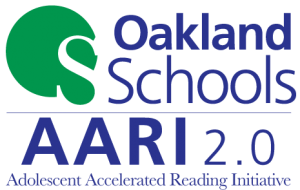
The Adolescent Accelerated Reading Initiative (AARI) is a Tier 2/3 (MTSS) short-term, intensive intervention that accelerates reading comprehension and critical thinking in informational text. AARI is for general and special education students in grades three through twelve and English Learners with a minimum overall WIDA proficiency score of 3.0. The instructional framework is built on evidence-based strategies and culture-centered research.
AARI focuses on critical thinking with informational text to help students access content from texts.
AARI emphasizes small group instruction that meets students where they are and accelerates their reading through instruction built around:
AARI seeks to support students in building more positive reader identities that empower them in all aspects of their lives.

Jill joined Oakland Schools after a decade as an ELA, political science, and reading intervention teacher in a local high school. In her role at Oakland Schools, Jill is a reading interventionist with District and School Services (School Culture and Climate Unit) and partners with Special Education colleagues. She works largely with the Adolescent Accelerated Reading Initiative, a reading intervention framework that accelerates students’ literacy skills (focused on reading comprehension) and critical thinking in expository text for grades three through twelve. Jill supports AARI educators and their colleagues of various disciplines through an ever learning and growing community of dedicated educators.
Jill also supports educators and districts in accelerating reading comprehension in non-fiction texts, leveraging speaking and listening in literacy learning, exploring strategies for questioning students in text, making text visible through text structures, and implementing classroom libraries. One of the best parts of being an educator is being a lifelong learner, so Jill is always busy learning more alongside classroom teachers.
Growing up, Jill lived all over Michigan, but came to the area to attend Oakland University (Go Golden Grizzlies!). Outside of the office, she is involved in a local faith community, stays active, mentors young women, and enjoys living life with her two favorite guys.